All the waste knots cut, all the threads secured – ’tis the finish of this second practice piece on my quest to learn how to wield a tambour hook with accuracy, (relative) speed, and ease.
When working with the tambour needle – and really, when working in any embroidery technique – practice is essential if you want to be perfectly comfortable with the tools, no matter what circumstances you find yourself in.
I prefer practicing on a particular design, rather than in random blobs, rows, and patches. When practicing on a design, there’s that whole Sense-of-Accomplishment Thing going on, you know?
Keep in mind that this project was a practice piece. There wasn’t much planning that went into it. With a little tweaking in shades and placement of colors in the design, I think the finished piece could be much improved. But here it is, anyway, for what it’s worth!
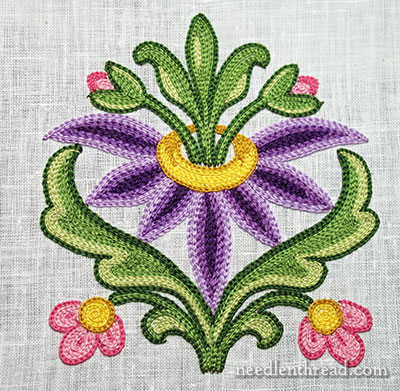
Because of the boldness of the colors, the contrast in the colors and shades, and the placement of some of the colors, it ends up looking a little cartoony, doesn’t it?
If you’d like to use the design for a practice piece, too, here’s the materials information:
Tambour Work Flower Materials
Embroidery pattern: The pattern for the tambour work flower above is available here on Needle ‘n Thread, for free. Scroll to the middle end of the post, for the printable PDF version.
Fabric: I used a small scrap of shadow work linen, but you can use any linen or cotton that has a close weave.
Threads: Coton a broder 25 (DMC Art. 107) in the following colors:
Purples (light to dark): 209, 552, 550
Greens (light to dark): 3348, 3347, 3345
Yellows: bright yellow 743, gold-ish yellow 783
Pinks: light 604, dark 602
Tambour hook – I used a #110
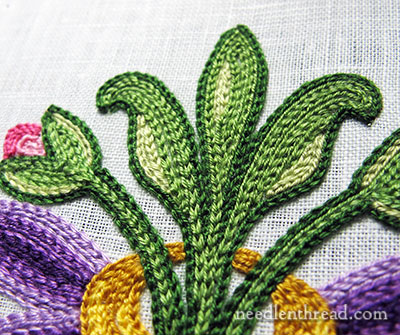
The other day when we looked at tambour flower for the first time, I mentioned several learning points. Well, they just keep mounting up!
The pattern makes for a good graduated study in following paths to fill shapes, for example.
When starting out with the petals, the filling is fairly straightforward and easy. Just start from the outside and work into the middle.
The large leaves get a little more complex. The other day, I mentioned the point about working mirrored elements, one immediately after the other.
With the stamens and little buds in the photo above, I worked the outline first in the dark green to set my perimeter. Then I worked in the “blobs” of light green, and finally, I filled around them with the medium green.
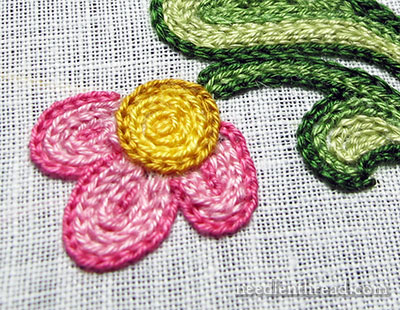
With the pink flowers, I worked the outlines and the dark pink lines inside first, and then filled around them with the light pink.
I had to fudge a lot on a couple of the petals, to get them filled. Next time, I’ll try filling shapes like these with a different approach. I’ve got something in mind that I think would work better, but that needs testing.
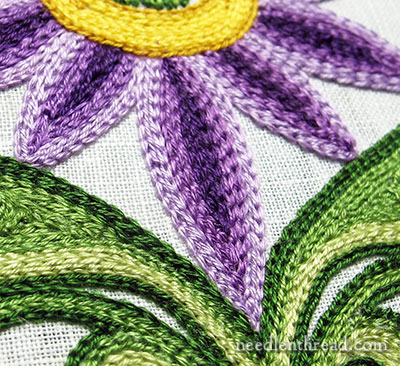
My favorite part of this whole piece is the purple. I like the light-to-dark on the leaves.
But I also think the light-to-dark on the leaves contributes to an incongruous look to the whole finished piece.
All the greens, for example, are outlined in dark. But then the purple is outlined in light and works in to the dark.
If you look at the whole piece and squint, you’ll see that the purple kind of sinks away in a lack of definition, compared to the green around it.
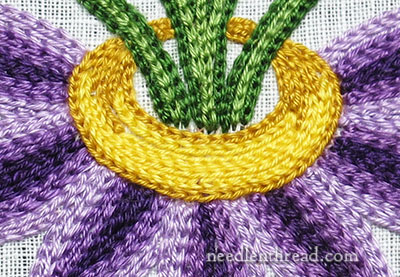
I like the way the ring turned out, even though I’m not fond of that bright-bright yellow, and there is a little glitchy thing going on, over there on the right side of the ring.
But what really needs improvement here is the way the elements meet up. The base of the stems is a bit jagged next to the outline of the ring.
Notice that the ring covers up the same type of jagged starting area on the purple petals.
Moral of the story (which is often the case in embroidery!): start with the elements farthest back in the picture first, and then build on top of them.
I worked the petals first, then the ring, then the stems. I should have worked the petals first, then the back of the ring between the stems, then the stems, then the front of the ring.
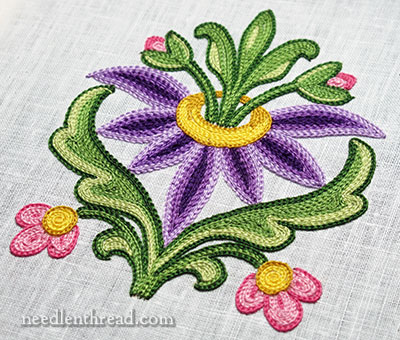
Overall, it was a good learning experience, and I enjoyed working this little tambour flower. Lots of room for improvement, and plenty of points to practice on in future sessions!
Tambour News
The book Tambour Work that I reviewed last week is officially “out of print” – the publisher no longer has stock.
It’s also completely out of stock at Hedgehog Handworks. Rumor has it, the publisher may reprint the book – more information on that should be available by December.
In the meantime, it looks like Silent Stitches might still have some copies left (scroll about 2/3rds down the page) for $24.95, but I’d drop them a line first, to make sure (since the publisher no longer has stock).
Don’t Forget!
If you haven’t signed up for the tool caddy give-away, it ends tomorrow morning, so today’s your last chance!







Dear Mary
You embroidered this quickly and it looks lovely and the pattern is so nice, I like the different contrast of threads you’ve used it makes it look more interesting. I can’t wait to try and practice Tambour embroidery. I can’t see any glitches in your work it looks perfect. It’s a shame about the book being out of print I hope they re-publish it as I’m sure there is a lot of interest. Thanks for showing us more Tambour I can’t get enough and really look forward to your tutorial.
Regards Anita Simmance
Before your current blogs on tambour work, when some one mentioned tambour, the first thought that came to mind was course wool on linen/cotton that is sold to represent crewel embroidery for upholstery. Being a lover of fine crewel wool on linen you can understand how adverse I was to that look! Then a second thought brought to mind fine linen lawn hankies and perhaps 18th century French clothing – lovely, but not something I would be interested in doing myself.
I think the diversity in your blog is why I read you every day!!! Now you have me thinking about all sorts of ways tambour work can be incorporated in items I would make. Perhaps a few tea towels for Christmas gifts, or some quick table napkins, and on and on… Thanks for opening my eyes and expanding my mind a bit!
Your work is pretty. What is the finished size of the embroidery?
Wow, I do like this. Love the colors, love the design and love the texture. It makes me think of all the passion flowers blooming along the track where we walk at the golf course. Wonderful.
Kind of silly to be replying to my own comment but I wrote before I read your article. I was so excited about how pretty it all is.
I see what you mean about the petals being in reverse of everything else. On the other hand, I like it. It’s less like a coloring book (dark lines and fill in the colors) and the petals seem to glow with the light edges. There’s enough contrast in the color from the fabric that I think they show up quite well. A little incongruity 🙂 makes it interesting.
Mary, thank you for doing this series on tambour embroidery. I’m trying to learn it on my own, and your articles are hugely helpful. Would you include a post on how to make a sharp turn?
I found a short section on tambour in Therese de Dillmont’s Encyclopedia of Needlework. She shows a tambour thimble, and I’m still thinking about how this would be used and what it would facilitate.
The flower is delightful! How large is it?
Question – Could tambour be combined with other types of embroidery? I have recently taken a keen interest in your blog. Your attention to fine work and explanation is wonderful. What I have running around in my head is using tambour as outlining and some punch needle as the center or fill in work.
Yes, you can! In fact, I’m working on a wool design that involves tambour chain stitch and some other stitches. Anywhere you use chain stitch, you can use a tambour needle. There are also some other stitches you can do with a tambour needle, but more on that later!
Thanks for the info on the way you advise to start to avoid the rugged parts. It does make sense when explained.
I am new with the tambour work. I just got my Lacis Tambour Hook and i am starting to gather info and materials. I love your YouTube video, i wish you had more of those. Could i use Nylon Thread Size, 18 to do chain stitch? There is multicolored one name Fiesta Mix that would make a beautiful effect if i could use it.
Thank you in advance for your answer.
Juan
Hi, Juan – I haven’t tried it with nylon thread… Why not give it a try and see how it works? Glad you like the video! I plan to do more in the future – just haven’t had a chance yet.
Thank you for the article on flour sack towels. I have a bin of them that I bought some years ago. Six of them I appliqued kitchen motifs on and they are still in use today after some five years. They are beginning to show wear so embroidery is perfect timing. I did not know about washing them before doing the art work, so thank you so much for that tip. Love your site and have learned so much.
Awesom
Hello! I accidentally cancelled my subscription to the newsletter and have tried many times to sign-up again but it tells me my email is not correct and to use another – I don’t have another. Can you help please. Many thanks.
Ok! I added you! You should receive an email to confirm the subscription. There’s a link in it to confirm. If it doesn’t arrive in your inbox, just check your spam filter and the like.